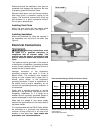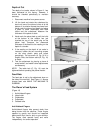
13
tensionin
g
ad
j
ustment, and to set the roller
back to the original height.
3. The spring which is located above the
bushing block (see Figure 15) must not
be compressed too tightly, as this will
restrict movement of the infeed roller and
may cause machine damage due to flexing
of the roller. Lift up the infeed roller with
your hand – there should still be sufficient
travel in the infeed roller.
4. If necessary, continue to adjust tension and
height in combination with one another,
while being careful to prevent excess spring
compression.
5. Repeat for the other end of the infeed roller.
The tension should be equal at both ends of
the roller.
Chipbreaker
The functions of the chipbreaker are to break
chips into small pieces, help avoid splintering of
the wood, help avoid board bounce on thinner
boards, and to direct the flow of chips out of the
machine.
The chipbreaker is factory adjusted to be 1/32”
below the cutting arc of the knives. Tension is
adjusted by the screw and spring (D, Fig. 15).
The height is adjusted with the socket head
screw (E, Fig. 15).
Some molding applications may require the
spring tension to be relieved to avoid scraping
the profile of a part.
A chipbreaker set too low
may prevent stock from feeding into the
machine.
NOTE: If the infeed roller setting is altered, the
chipbreaker tension may need to be readjusted
as well.
Outfeed Roller
The outfeed roller should exert enough pressure
to pull the board through the cutterhead after it
leaves the infeed roller. The correct position of
the outfeed roller is 1/32” below the arc of the
cutterhead knives. If the board halts or bumps
when it first contacts the outfeed roller, tension
should be reduced. If the board stops or does
not continue feeding smoothly after starting
under the outfeed roller, then tension should be
increased. As with the infeed roller, height and
tension of the outfeed roller should be set in
combination with each other.
Figure 14
Figure 15


















